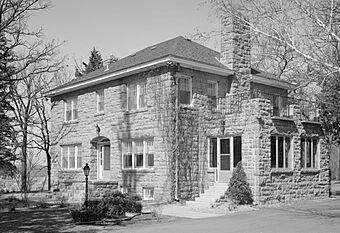Clark and McCormack Quarry and House facts for kids
Quick facts for kids |
|
|
Clark and McCormack Quarry and House
|
|

The John Clark House viewed from the south
|
|
| Location | Minnesota State Highway 23 at Pine Street, Rockville, Minnesota |
|---|---|
| Area | 12 acres (4.9 ha) |
| Built | 1907 (quarry), 1924 (house) |
| Architect | John Gordon Clark |
| Architectural style | Colonial Revival |
| MPS | Stearns County MRA |
| NRHP reference No. | 82003046 |
| Added to NRHP | April 15, 1982 |
The Clark and McCormack Quarry and House is a special historic site in Rockville, Minnesota. It includes an old quarry and the home of one of its owners. The Clark and McCormack Quarry started in 1907. It was famous for its beautiful Rockville Pink granite.
The John Clark House was built in 1924. It was made using granite from the quarry itself. This property is important because it was a major source of granite in Minnesota. It also shows how important granite quarrying was in eastern Stearns County.
Contents
What is the Clark and McCormack Quarry Like?
The Clark and McCormack Quarry started as a large dome of granite. This rock rose above the land around it. Workers first removed the granite that was on the surface. Then, they dug deeper, creating the pit you can see today.
The Unique Rockville Pink Granite
The granite from this quarry is very special. It has a rough but even texture. It also has large feldspar crystals. These crystals make the stone sparkle. When polished, it looks pinkish-grey. The stone's color and texture are very consistent. It also has wide spaces between its natural cracks. This made it easy to cut huge blocks of stone. The quarry also had very little waste rock. This is because most of its stone could be used.
How Granite Was Moved and Processed
In the early 1900s, workers used handcarts on tracks. They moved the rough granite blocks to workshops. These shops were around the edge of the quarry. Here, the blocks were cut and shaped.
Today, no old buildings are left right around the quarry. The first buildings were torn down as the pit got bigger. Some cutting sheds that lasted longer were destroyed in a fire.
The John Clark House and Garage
Across Minnesota State Highway 23 from the quarry stands the John Clark House. It is a two-story building. It has a sunporch on one side. The main entrance is in the middle of the wider, west-facing wall. The house has a hip roof with chimneys. Its walls are made of rough-cut granite from the quarry.
The property also has a separate three-car garage. It is at the southwest corner. The garage looks a lot like the house. It also has stone walls, a hip roof, and its own chimney.
History of the Clark and McCormack Quarry
John Clark was an immigrant from Scotland. He worked as a stonecutter in his home country. Later, he worked in Ohio, Michigan, and Canada. He finally settled in Saint Paul, Minnesota. He joined a company owned by Matthew Breen. Breen's company had opened Minnesota's first commercial quarry in 1868. Clark helped Breen start two new quarries in eastern Stearns County.
Starting His Own Business
In 1907, John Clark started his own business. He partnered with John McCormick from Saint Paul. McCormick had good connections. He helped them get a huge contract. They were to provide granite for the Cathedral of Saint Paul. This big church was being built in the capital city.
By 1912, their Rockville quarry was very busy. About 85 men worked there. They produced a lot of finished stone every day. McCormick left the partnership in 1916. He had only planned to stay until the cathedral project was done. After he left, the business became the John Clark Company.
A Leading Granite Producer
Just two years later, in 1918, the quarry was the biggest producer of structural granite in Minnesota. Granite from this quarry was used in many famous buildings. These include the Foley Square Courthouse in New York City. It was also used in a hospital in St. Cloud, Minnesota. Many other buildings across the country used its stone.
The quarry also helped Rockville grow. Many stonecutters came from Scotland and Scandinavia to work there. They were so numerous that they often played soccer games on Rockville's Main Street after work!
Building the John Clark House
John Clark lived in Saint Paul until 1924. That's when his house in Rockville was finished. It was built right across the road from the quarry. Clark's son, John Gordon Clark, designed the house. The company's stonemasons built it. This house is special because it's one of the few homes in Stearns County made from local granite. Usually, the granite was too valuable for anything but large public or business buildings.
In 1942, the John Clark Company was bought by Cold Spring Granite. This company is now called Coldspring.





